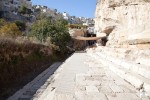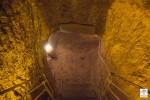Pool of Siloam (Shiloah)
(Nehemiah 3:15; John 9:7-11)
Ancient pool outside the Old City walls of Jerusalem, within the village of Silwan. One of the important water sources of ancient Jerusalem. Its water comes from the Gihon stream, mentioned in the Bible as one of the 4 rivers emanating from the Garden of Eden (Genesis 2:13).
Solomon was crowned King of Israel near the waters of Gihon (I Kings 1:45). The water was used for drinking and ritual purposes (the Temple libation) and the people attributed medicinal properties to it. Just before the siege of Jerusalem by Sennacherib, King Hezekiah had a tunnel bored through solid rock to divert water of the Gihon Spring into the Pool of Siloam, then outside the city wall (II Kings 20:20). The tunnel, 513 meters (1683 feet) long, was constructed by borers working from two ends and meeting in the middle. This meeting and the completion of the work was commemorated on a plaque, discovered in 1880, with an inscription describing the task (Siloam Inscription).
The pool is called Pool of Shelah in the Book of Nehemiah (3:15). It is also associated with Jesus’ miracle of the blind man who washed in the pool and regained his sight. “A man that is called Jesus made clay, and anointed mine eyes, and said unto me, Go to the pool of Siloam, and wash: and I went and washed, and I received sight.” (John 9:7-11) .
The Greeks called the site Sileus and it was corrupted in Arabic to Silwan. Christian Arabs call the pool Ein Sitt Maryam (Spring of Lady Mary, mother of Jesus).




